HOW-TO VIDEO AND
PRODUCT REVIEW
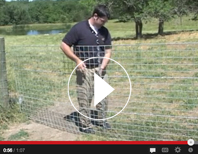
The above video shows how easily PowerBilt® panels can be attached using our Wire Connector Hinge.
Premier's PowerBilt® Panels are the best for our goats. As most already know, goats love to climb on anything they can, but the PowerBilt panels have stood up to the abuse. (The farmstore panels didn’t last.) We use these panels for kidding jugs, paddock gates and as a temporary holding pen for loading goats into the back of our truck. The small 3" x 3" holes are great, and very few kids get their heads stuck in the panels. When we are done kidding, all we have to do is fold up the panels and stack them. Then we bring in the Uniloader to clean out the barn. It beats cleaning out individual pens by hand.
By Sara McArtor
Premier Product Consultant
The McArtor family raises Boer goats for showing 4-H, open shows and meat production.
TRANSPORTING SOLUTION
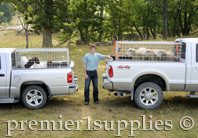
Premier's pickup haulers fit in trucks big and small. They set up easily in any pickup with at least a 6 ft bed.
Premier's Welded Wire Panel Pickup Haulers
| • |
Problem: Need to transport a few goats, ewes or dogs but don’t have a pickup carrier.
|
| • |
Solution: Use a Premier livestock pickup hauler for containing and transporting animals. It fits inside the truck wheel wells and also allows the tailgate to close.
|
We offer 2 solutions: Small pickup hauler for pickups with a 6 ft bed, and large pickup hauler for pickups with a 7 ft bed.
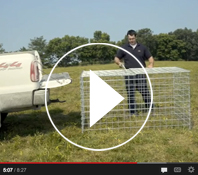
View our how-to assemble a large pickup hauler video above. Also view our small pickup hauler video. We also have assembly instructions that can be printed for your convenience.
BUILD YOUR OWN FEEDERS
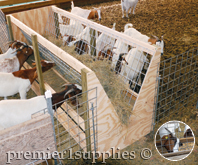 Why Premier's "Build Your Own Feeders" pleases users…
Why Premier's "Build Your Own Feeders" pleases users…
| • |
Minimal waste. The panels prevent silage or hay from being pulled into the pen and onto the ground. Goats and sheep must work for each mouthful.
|
| • |
Less risk of injury. Entering the pen is not required—so even children can safely feed hay and/or grain.
|
| • |
Grain, silage and hay can all be fed in this feeder. Saves space and reduces cost.
|
| • |
Saves $$. Make your own feeders and use local lumber to do so.
|
| • |
Proven. They have been in use across the nation for years—and are now even copied by our competitors, which is the ultimate compliment.
|
| • |
Single-sided or double-sided designs available (see below).
|
| • |
Two panel inserts available:
30" x 48" for goats and
24" x 48" for rams.
|
How-to Instructions:
|
 |
 |
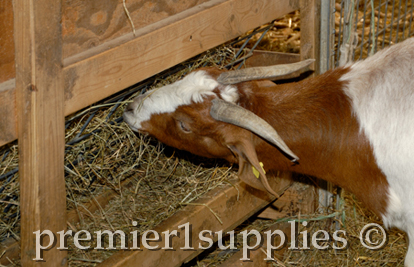 Current meat goat prices are high enough for people to consider how to raise more of them. The key, as always, to any livestock expansion, be it small or large, is to do so with as little extra labor as possible without loss of goat health, growth and productivity.
Current meat goat prices are high enough for people to consider how to raise more of them. The key, as always, to any livestock expansion, be it small or large, is to do so with as little extra labor as possible without loss of goat health, growth and productivity.
In this and future newsletters we will feature articles and products to help you do this.
BUYING IN STORED FEED
What to Look for When
Buying Hay
By Gary Fredricks, Dairy and Livestock Extension Agent,
Clark and Cowlitz Counties, Washington
Color
The first thing to notice when inspecting the hay is its color. Good quality hay will have a nice green color that is neither yellow nor brown. Good hay color tends to be associated with higher vitamin, protein, and mineral levels. An overall brown color indicates more mature hay and a corresponding lower quality.
Maturity
Before examining the hay bale for maturity, it is necessary to first understand what plant maturity means in terms of forage quality. Grass and legume plants are cut to make hay, and plants are made up of leaves and stems. The leaf contains most of the plant protein and the highly digestible fiber that is easily converted to energy. The young leaf is soft and flexible, and is low in cellulose. Cellulose is part of the cell wall and provides rigidity to the cell structure. The stem is mostly composed of cellulose because it needs to be more rigid to allow the plant to grow upright. Cellulose is low in energy and is not broken down easily in the animal’s digestive system. After a plant emerges and begins to grow, the weight of the leaf as a percentage of the total plant is high, while the percentage of stem is low. As the plant matures, the percentage of leaves decreases while the percentage of stems increases. Thus, the more mature the plant, the lower the percentage of leaves and the lower the protein and energy contained in the whole plant.
Number of Leaves vs. Stems
When you evaluate the hay for maturity, look for the number of leaves versus stems. As explained above, you want to see more leaves than stems. As the number of stems increases, the desirability of the hay goes down. Also note that the longer the leaf length, the more mature the hay and the lower its quality. In addition, the presence of seed heads in the bale indicates a very mature hay with lower energy and protein values.
Read More »
|
WIRE PANELS THAT WORK
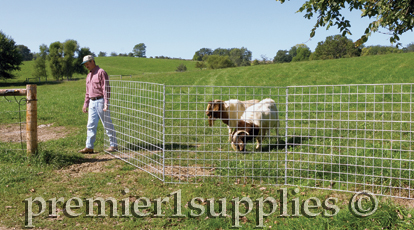
Need a "goat proof" field entrance? Panels are easy to use and strong enough to stop goats.
Goats can be tough animals to keep contained. They are nimble, inquisitive and stubborn. Premier is fortunate to have lush pastures, and we make sure our fences are tight. If that were not the case, our goats would be down the road. But when the goats aren't in the pasture, we need something that will keep them in. That's why our farms and barns have so many panels in use. Panels keep our goats where we want them.
Uses for wire panels…
| • |
Pen dividers—PowerBilt® panels used as a pen divider. We use 48" tall panels here because some goats are “athletic” and escapes can be expensive.
|
| • |
Pen gates—Panels between feeders act as entry/exit gates to pens. Connect them with large screw-in eyebolts and 1/2" diameter connecting pin. Pulling a stake at one end allows access into a pen. Removing stakes at both ends allows animals to enter/exit.
|
| • |
Kidding jugs—Select height 36" and 48" panels or 40" panels according to your animals’ behavior (wild vs relaxed, athletic vs calm) and your preferences (tall vs short). We use connector hinges or braided nylon cord to tie jugs together and snap clips as latches.
|
|
|
| • |
Sale barn pens—Kalona (IA) Auction Barn uses Premier’s wire panels to build temporary pens for special sales.
|
| • |
Field gates—(see large photo above) Unlike steel bar gates, wire panel gates stop dogs, coyotes, kids and lambs from crawling through. Premier’s wire connectors act as a hinge within the gate. Multiple panels will interconnect to fit different gate openings.
|
| • |
Shows/fairs—The Monroe County Fair (Michigan) upgraded its goat barn with 48" panel pens. No goats were able to escape!
|
| • |
Pickup haulers—Use a Premier livestock pickup hauler (see our video at left) for containing and transporting goats, sheep, guard dogs and other small animals. It fits inside the truck wheel wells and also allows the tailgate to close.
|
|
VIP ARTICLE
Basic Goat Feeding Guidelines
By Dr. Dan Morrical, Professor of Animal Science,
Iowa State University Teaching Farm
Finding information on feeding goats is very limited. The most common problem that I have dealt with lately is ketotic nannies in late gestation from being over conditioned. Allowing goats unlimited access to high quality hay results in over conditioned goats. In many situations, producers feed extremely high quality hay to reduce waste. Because many producers have limited experience feeding livestock, they allow the goats to decide how much hay is offered rather than limiting the amount fed, therefore forcing goats to be less picky. Feed costs account for the largest portion of production costs. Producers who want their goat herd to make money must evaluate their feed costs. My reference for determining nutrient needs is the Nutrient Requirements of Goats, 1981 published by National Research Council. Factors which impact the nutrient requirements include weight, age, stage of production and level of production. Goat weights are extremely variable with pygmy nannies weighing 30-50 pounds, Angoras in the 65-100 pounds, Spanish nannies might be only slightly larger and Boer nannies could weigh up to 175 pounds. The daily nutrient needs very almost threefold for the previous goat breeds mentioned. Lactation is the highest nutrient demand and requires the most feed.
The Goat NRC breaks down the requirements into maintenance, growth, pregnancy and lactation. The maintenance stage has adjustments for level of activity. Midwestern goats grazing high quality pastures would have only a minimum increase in their maintenance requirements. However, Spanish goats grazing West Texas brush country have at least a 50% increase in activity searching for something to eat, which increases the maintenance requirement. The major nutrient of concern for goats is energy stated in pounds of TDN required per day. A 130-pound nanny would require 1.34 pounds of TDN for maintenance. That level of energy can be provided by 2.6 pounds of average hay. Protein and minerals are of a concern in the ration, but if energy levels are met then most of the time other nutrients are also met. Compared to sheep, goats have a lower protein requirement due to slower growth rates and less fiber production. Angora goats would be an exception to that rule but their slow growth counteracts the need for extra protein.
Feeding goats can be a real headache for a couple of reasons. One is their ability to selectively consume feeds. This results in excess waste if not controlled by the manager. Second management difficulty is handling the extreme pecking order established in the group. Horned goats are probably worse than dehorned goats in regards to aggressive behavior. As one tries to restrict the amount of feed offered, the boss goats consume more than their share. Many producers try to overcome this problem by providing multiple feeders so that all goats can find a safe place to eat. Another solution to this situation is split goats up into smaller groups so that the timid eaters have a better opportunity for consuming their fair share.
|
|